- Mt. Shirouma - Renge Hot Springs Lodge

Road & Geosite Conditions
Fully Accessible

- Number
- Area
- 1. Ichiburi Geosite
- 2. Oyashirazu Geosite
- 3. Omi Coast Geosite
- 4. Omigawa Jade Gorge Geosite
- 5. Imai Geosite
- 6. Itoigawa-Shizuoka Tectonic Line and Salt Trail(North) Geosite
- 7. Maikomidaira Geosite
- 8. Hashidate Gold Mine Geosite
- 9. Kotakigawa Jade Gorge Geosite
- 10. Tsugami Shindo Geosite
- 11. Himekawa Gorge Via Oito Line Geosite
- 12. Itoigawa-Shizuoka Tectonic Line and Salt Trail(South) Geosite
- 13. Himekawa Gorge Geosite
- 14. Renge Geosite
- 15. Itoigawa Coast Geosite
- 16. Miyama Park and Museums Geosite
- 17. Tsukimizunoike Geosite
- 18. Umidani Gorge Geosite
- 19. Amakazariyama Geosite
- 20. Yakeyama Geosite
- 21. Benten-iwa Geosite
- 22. Shindosan Geosite
- 23. Gongendake Geosite
- 24. Tsutsuishi Hamatokuai Geosite
- Jade
- 1. Ichiburi Geosite
- 2. Oyashirazu Geosite
- 3. Omi Coast Geosite
- 4. Omigawa Jade Gorge Geosite
- 9. Kotakigawa Jade Gorge Geosite
- 15. Itoigawa Coast Geosite
- 16. Miyama Park and Museums Geosite
- Fossa Magna
- 5. Imai Geosite
- Itoigawa-Shizuoka Tectonic Line and Salt Trail(North) Geosite
- 11. Himekawa Gorge Via Oito Line Geosite
- 12. Itoigawa-Shizuoka Tectonic Line and Salt Trail(South) Geosite
- 13. Himekawa Gorge Geosite
- 17. Tsukimizunoike Geosite
- 21. Benten-iwa Geosite
- 22. Shindosan Geosite
- 24. Tsutsuishi Hamatokuai Geosite
- Mountainous areas
- 7. Maikomidaira Geosite
- 8. Hashidate Gold Mine Geosite
- 10. Tsugami Shindo
- 14. Renge Geosite
- 18. Umidani Gorge Geosite
- 19. Amakazariyama Geosite
- 20. Yakeyama Geosite
- 23. Gongendake Geosite

Although small in scale, the Itoigawa Coast was once covered with a line of small sand dunes about 10m in height. 40 years ago, these gently sloping dunes stretched out to the coast and were a popular ski area for young children in winter. Now these dunes have all but eroded away and along the shoreline, concrete tetrapod breakwaters and artificial reefs have been constructed to prevent further erosion. Remnants of a few boathouses left after the construction of the National Route 8 Bypass are all that remain to remind us of this foregone scenery.
It is believed that this sudden erosion was effected by the construction of dams along the Himekawa River basin, which reduced the amount of sand entering the region, and the construction of a large weir around Himekawa Port, which dramatically changed the coastal current. On the other hand, the construction of the National Route 8 Bypass created a revetment that has assisted in preventing further coastal erosion. In this way, Itoigawa Coast serves as a reminder of the unforeseen effects that development projects can have on the environment. The beach has now transformed from sand to pebbles, uncovering jade and other beautiful stones. Due to its convenient location, this beach remains popular with bathers in the summer.
 Itoigawa Coast (Jade Coast)
Itoigawa Coast (Jade Coast)
Also known as the Jade Coast, the Itoigawa Coast is famous for small pebbles of jade that can occasionally be found along the shoreline by skilled visitors. Itoigawa Coast was once covered in sandy dunes that stretch to the sea, but changing currents have almost entirely eroded the sand away. Despite this, the swimming beach here comes alive each summer as locals and visitors alike flock to cool off in the refreshing Sea of Japan.
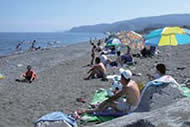
Closest Swimming Beach
to Itoigawa Station
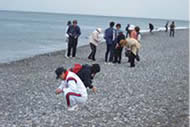
Jade Hunting
 Sea of Japan Sunset Lookout
Sea of Japan Sunset Lookout

Sunset over the Sea of Japan
The Sea of Japan is known for its dazzling sunsets and this lookout deck is a great place to see them. Located only a 4 minute walk from Itoigawa Station, enjoy panoramic views of the Sea of Japan. On clear days you can see as far away as Noto Peninsula or Sado Island! The deck also offers a good view of downtown Itoigawa and the many mountains that tower over the Itoigawa UNESCO Global Geopark' s southern region.
 Souma Gyofu House
Souma Gyofu House
 Itoigawa Museum of History and Folklore
Itoigawa Museum of History and Folklore
Souma Gyofu (1883 - 1950) was a poet, writer and scholar from Itoigawa who made a profound impact on the Japanese literary world. He is most well-remembered today for writing the lyrics to over 250 school songs around the country, including those of his alma mater, the prestigious Waseda University in Tokyo. He also wrote many folksongs, like the well-known children's song 'Haru Yo, Koi' ('Hurry, Spring'). His house is preserved here as it was when he lived in it and the Itoigawa Museum of History and Folklore features an impressive collection of his belongings, research materials and collections.
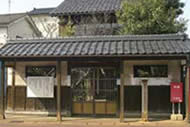
The Souma Gyofu House
Historical Landmark
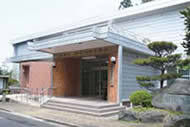
Itoigawa Museum of History
and Folklore
 Tanimura Art Museum & Gyokusuien Garden
Tanimura Art Museum & Gyokusuien Garden
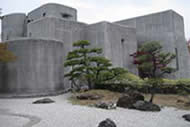
Tanimura Art Museum
Designed to appear like ruins rising from a desert, the Tanimura Art Museum was designed by famed architect Murano Togo and houses Buddhist artwork by Sawada Seiko. The museum is as much a piece of artwork as the statues inside with curves and hidden windows combining natural and artificial lighting to create an almost otherworldly atmosphere.
The adjoining Gyokusuien Garden is a beautiful Japanese Garden that combines nature and landscaping together in perfect harmony. Enjoy it during a relaxing break in the garden café.
 Amatsu Shrine
Amatsu Shrine
This shrine is also locally known by the name "Ichinomiya" and actually contains multiple shrines. Itoigawa's patron goddess, Princess Nunakawa, is enshrined in Nunakawa Shrine, while the larger Amatsu Shrine enshrines Amatsuhiko-Hiko-Ho-no-Ninigi-no-Mikoto, one of Japan's primordial gods. According to legend, Ninigi-no-Mikoto (as his name is often shortened) was sent by his grandmother, the sun goddess Amaterasu-Omikami, to plant the first rice plants on earth. Because of this connection to the rice harvest, its no wonder that Amatsu Shrine has taken such an important place in Itoigawa’s history.
The shrine’s largest festival is its Spring Grand Festival, also commonly known by the name "Itoigawa Fighting Festival (Itoigawa Kenka Matsuri)." Held every April 10th and 11th, this festival is named for its "fighting shrines" event in which large portable shrines are crashed into each other by teams of local young men. This spectacle is said to bless the region each year with a bountiful harvest. The court dance that follows the fighting shrines is centuries old is an Important Intangible Cultural Property of Japan.
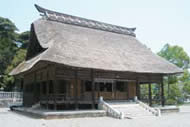
Amatsu Shrine Worship Hall

Fighting Shrines
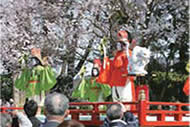
Bugaku Court Dancing
Princess Nunakawa

Princess Nunakawa and Son
Princess Nunakawa's story is recorded in the Kojiki, Japan's oldest historical record compiled in 712 at the request of the Emperor. She was a shaman princess said to be both beautiful and wise and she ruled over the land that is now Itoigawa. According to legend she wore pendants of jade and used them to perform magic. This legend was one of the clues that led researchers to rediscover jade in Itoigawa over 1000 years after it had been lost to history.
Princess Nunakawa has long been revered as a goddess and several shrines in Itoigawa are still dedicated to her worship. Nunakawa is Itoigawa's patron goddess, so her worship is largely centered here, but several shrines dedicated to her can also be found in neighboring Joetsu City.
Kaneko Azalea Garden
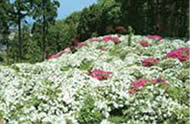
The Kaneko Azalea Garden is a 5,500 square meter private garden that features over 3,500 azalea plants. The azalea flowers blossom in mid May, covering the hillside in a dazzling sea of white and pink. The view of the Sea of Japan from here is not to be missed!
※The Kaneko Azalea Garden is located in a private residence, please be respectful.
Route to Itoigawa Coast Geosite
Destination:

